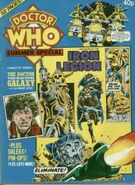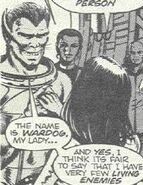| This page contains a list of all the comics included in Doctor Who Magazine Vol 1: . If you have found something that is not seen on this page, please add it to this list. (This template will categorize articles that include it into Category:Comic Lists.) |
||
Back to title selection : Comics D : Doctor Who Magazine Vol 1

Doctor Who Weekly
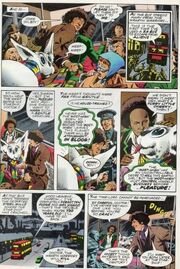
Art from "the Star Beast" by Dave Gibbons

Art from 'Deathworld'
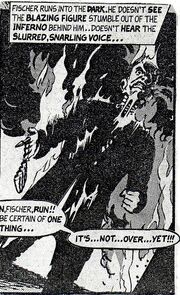
A scene from Alan Moore's chilling Doctor Who story Business as Usual.

Art from "The Tides of Time" by Dave Gibbons


Doctor Who Weekly, the brainchild of Marvel UK's incoming editorial director Dez Skinn (who believed that with Sci-Fi now very much the in thing following the success of Star Wars, a title based on Doctor Who would be an obvious move), was launched on 17th October 1979, initially featuring a comic strip (The Iron Legion) starring The Doctor (by writers Pat Mills and John Wagner and artist Dave Gibbons) plus a backup strip initially featuring the Daleks (and later various other aliens including the Cybermen) and a reprint of a classic sci-fi book adaptation from the US version of Marvel Classics Comics, plus a few short articles on the Doctor's televised adventures and old enemies (the first three issues also gave away free gifts, rub-down transfers which could be placed on a background provided with the first issue).
Doctor Who Monthly

The weekly was a success, but Marvel quickly realized that the majority of the readership were slightly older than the average readership of the weeklies, so they changed the frequency following issue #43, the title becoming Doctor Who Monthly with #44 (September 1980; in fact, early issues were titled Doctor Who — a Marvel Monthly, though this was soon shortened). With the change to monthly frequency, the classic strips were dropped and the amount of space dedicated to articles gradually increased until the comic strip content was a comparatively minor part of the magazine (eventually, the backup strips were also dropped, though Marvel did begin running reprints of the classic The Dalek Chronicles strip from TV21 on the back covers. In the meantime, though, the backups gave us a number of underrated gems from creators such as Steve Dillon, Steve Moore, Alan Moore and David Lloyd).
Spin-off stars
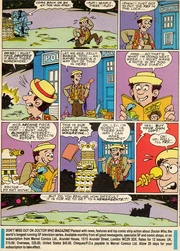
Promotional ad from 1988
The magazine also gave birth to several original characters who would go on to become minor Marvel stars in their own right, including Abslom Daak, Dalek Killer, the Special Executive, Kroton the Cyberman, the Sleeze Brothers and the Freefall Warriors (as well as giving the Doctor a rather...unique...new companion in the shape of Frobisher, a shape changer trapped in the form of a penguin, who later found his way into Doctor who stories in other mediums).The title eventually changed to the now more familiar Doctor Who Magazine. See Doctor Who in comics for more detail on this period.
Doctor Who Magazine and move to Panini

The twelfth Doctor
Over the years, the magazine spawned a number of spin-offs, notably Doctor Who Classic Comics, various Doctor Who Specials, the Doctor Who Yearbook and Doctor Who: It's Bigger on the Inside (a collection of the humorous Doctor Who? strips by Tim Quinn and Dicky Howett which ran on the letters pages for several years). It also helped launch the career of another Marvel UK star (later adopted by Marvel in the US), the robotic mercenary Death's Head, who guest starred in the Doctor's strip after first appearing in the pages of Transformers; later, the Doctor himself would make a surprise appearance in Death's Head's own book!
When Marvel UK folded in 1999, Doctor Who Magazine was sold to Panini, who still publish it today. The comic strip remains a regular part of the magazine, drawn by artists such as Mike Collins and Martin Geraghty and scripted by writers including Scott Gray and Jacqueline Rayner, but it is no longer a 'comic' in the sense that Doctor Who Weekly was, and the target audience is now very definitely adult readers. The magazine received an overhaul in 2005 to coincide with the return of Doctor Who to television, becoming thicker, squarebound and with a higher price. It is the world's longest running periodical based on a television programme.
Earlier Titles
(See relevant pages; Doctor Who Weekly Vol 1 and Doctor Who Monthly Vol 1)
Doctor Who Magazine Gallery
DWM Related
See Also:
Back to title selection : Comics D : Doctor Who Magazine Vol 1

















































































































































































